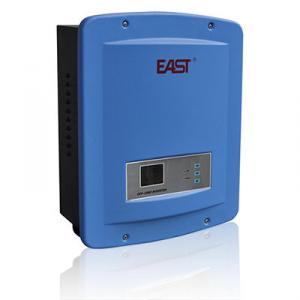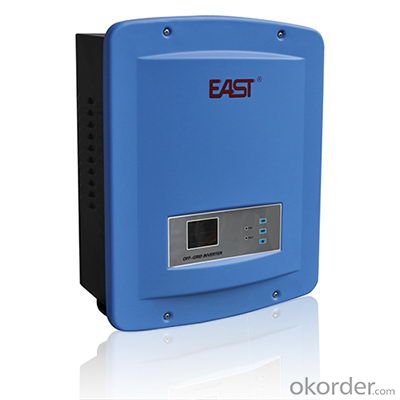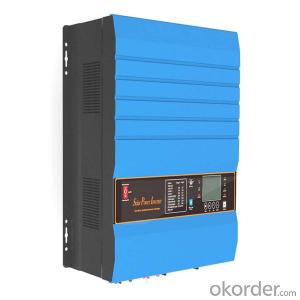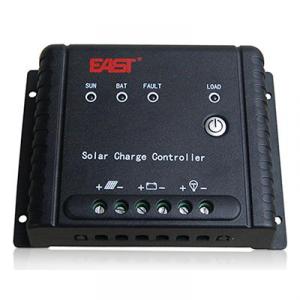Off-Grid Solar Inverter 100W-2400W Excellent Performance, Hige Stability
- Loading Port:
- China main port
- Payment Terms:
- TT or LC
- Min Order Qty:
- 1 pc
- Supply Capability:
- 1000 pc/month
OKorder Service Pledge
OKorder Financial Service
You Might Also Like
Off-Grid Solar Inverter 100W-2400W
EA-GF series products are on the basis of green energy use and equipment electricity need for remote area, combing the electricity characteristics of household appliances, communication station equipment and computer peripheral equipment. They have the fuction of enery conservation and environment protection. They adopt MCU control techniqute, having various kinds of function such as multi-setting mode, MPPT control, voltage stabilization on line, short-circuit protection, inverter frequency adaptive, output overload, batter charging management, monitoring etc. EA-GFseries products are the ideal power supply delivered with excellent performance, hige stability, high reliability and practical applicability.
● Multi-setting
※PV priority mode or AC priority mode
※Choose the charging current based on the configured capacity of the battery
● High reliability: Double MCU digital control
※Independent MPPT (Maximum Power Point Tracking) control microprocessor system
※Independent inverter microprocessor control system
● Isolated and pure sine wave technology
● LCD+LED display
● Wide input range
● High-speed synchronous conversion
● Friendly alarm system
● Online protection function
● Frequency auto adaptive
● Intelligent No-load auto shutdown technology (optional)
● Intelligent monitoring (RS232, USB, or SNMP card, optional)
Model | GF100 | GF400 | GF500 | GF800 | GF1000 | GF1500 | GF2000 | GF2400 | |
Power | 100W | 400W | 500W | 800W | 1000W | 1500W | 2000W | 2400W | |
Battery Voltage | 12Vdc | 12Vdc / 24Vdc | 24Vdc | 24Vdc | 48Vdc | 48Vdc | |||
Working Mode | PV priority / AC priority | ||||||||
PV | |||||||||
Input Voltage Range | 12Vdc-25Vdc | 12Vdc-25Vdc(12V) 24Vdc-45Vdc(24V) | 24Vdc-45Vdc | 48Vdc-90Vdc | |||||
Suggested Voltage Range(Vmp) | 15Vdc-17.8Vdc | 15Vdc-17.8Vdc(12V) 30Vdc-36Vdc(24V) | 30Vdc-36Vdc | 60Vdc-71Vdc | |||||
PV Current(Imp) | ≤20A | ≤40A | ≤40A | ≤60A | ≤80A | ||||
Max. Charge Current | 5A/10A/20A | 10A/20A/30A/40A | 10A/20A/30A/60A | ||||||
Conversion Efficiency | ≥ 98% | ||||||||
Display | |||||||||
Panel Indicator | LCD + LED | ||||||||
AC mode | |||||||||
Input Voltage Range | 100/110/120/220/230/240VAC±25%(customized) | ||||||||
Input Frequency Range | 45-65 Hz(Automatically transfer to inverter power when overfrequency) | ||||||||
Output Voltage Precision | 100/110/120/220/230/240VAC± 10% | ||||||||
Input PF.(AC/DC) | ≥98% | ||||||||
Charge Current | 12A max | ||||||||
Efficiency (Mains Mode) | ≥ 96% | ||||||||
Overload | 110% 255s transfer to bypass model; 120% 60s transfer to bypass model; 150% 10s transfer to bypass model; | ||||||||
Short Circuit Protection | Input fuse | ||||||||
Inverter Mode | |||||||||
Inverter Output Voltage | 100/110/120/220/230/240VAC± 5% | ||||||||
Output Frequency | 50 Hz / 60Hz ± 1% frequency auto sense | ||||||||
Wave Form Distortion | Linear load≤ 5% | ||||||||
PV-AC Transfer Time | 5 ms typical value; Max.8 ms | ||||||||
Max.Efficiency | ≥ 84.5% | ||||||||
Inverter Overload | 110% 255s transfer to bypass model; 120% 60s transfer to bypass model; 150% 1s transfer to bypass model; | ||||||||
No-Load Off(Optional) | Load< 5% The system automatically shut down at 1MIN, transfer to bypass power supply | ||||||||
Short Circuit Protection | Systems automatically shut down | ||||||||
Alarm | |||||||||
Mains Abnormal | 1/4s; automatic sound elimination after 40s | ||||||||
Low Battery | 5/1s | ||||||||
Overload | 1/1s | ||||||||
Communication Interface(Optional) | RS232 / USB / SNMP(Setup available for regular start/shutoff) | ||||||||
Others | |||||||||
Surge Protection | Optional | ||||||||
EMC | EN62040-2:2006;EN61000-3-2:2006; EN61000-3-3:2008 | ||||||||
IP Class | IP21 | ||||||||
Ambient Temperature | 0℃ ~ 40℃ | ||||||||
Ambient Humidity | 10% ~ 90%(Non Condensed) | ||||||||
Noise | ≤ 50dB | ||||||||
Dimension (WxDxH)mm | 315×458×147 | 380×480×202 | |||||||
Packing Dimension (WxDxH)mm | 380×500×195 | 458×545×278 | |||||||
Weight (kg) | 9.8 | 11.0 | 12.0 | 18.7 | 19.2 | 19.6 | 27.6 | 29.3 | 29.3 |
Packing Weight (kg) | 10.8 | 12.0 | 13.0 | 20.0 | 20.5 | 20.9 | 28.9 | 30.6 | 30.6 |
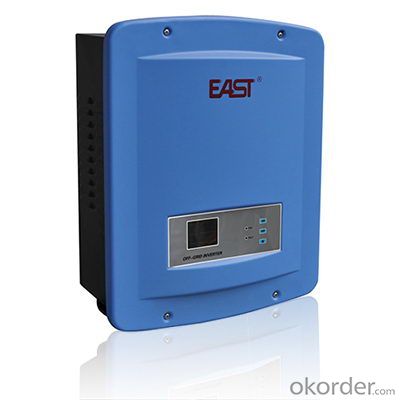


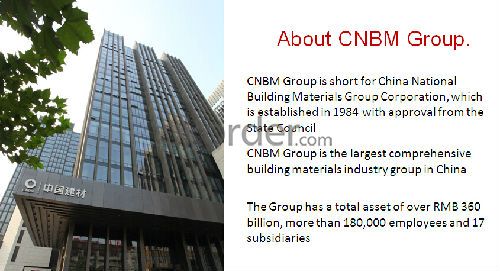

· Q. What is an UPS and What it is for ?
An uninterruptible power supply (UPS) is a device that allows your computer or telephone switch or critical equipement to keep running for at least a short time or longer time when the primary power source is lost. It also provides protection from power surges, spikes, brownouts, interference and other unwanted problems on the supported equipment.
· Q. How long the UPS to run when power goes?
This can take 3 paths.
1.You can pick a UPS that is rated for pretty much the full VA you need so it will be running at 100% of capability and will thus last 'n' minutes.
2.You can pick a UPS that is rated at a much higher VA value than you really need so, for example, is running at 50% of capability and will thus last for longer than the UPS from option 1.
3.You can use extra external battery packs to run for longer. If charging capability allows, the more and the bigger batteries you take with, the longer time UPS runs.
or using a generator after about 6 hours, it will be more cost-effective, with a short runtime UPS to bridge the generator start-up gap.
- Q: Is it possible to monitor the performance of a solar inverter remotely?
- Yes, it is possible to monitor the performance of a solar inverter remotely. Many modern solar inverters come with built-in monitoring capabilities that allow users to track and analyze the system's performance from a remote location. This can be done through dedicated monitoring portals or mobile applications which provide real-time data on energy production, system efficiency, and any potential issues or faults. Remote monitoring enables users to optimize the performance of their solar inverter, identify any maintenance or operational requirements, and ensure the system is operating at its maximum potential.
- Q: How does a solar inverter handle voltage fluctuations from the grid?
- A solar inverter handles voltage fluctuations from the grid by continuously monitoring the incoming voltage. When fluctuations occur, the inverter adjusts its internal components to maintain a stable output voltage. It does this by regulating the power conversion process, either by decreasing or increasing the output voltage as necessary. This ensures that the solar energy generated by the panels remains at a consistent level, regardless of the voltage fluctuations from the grid.
- Q: Can a solar inverter be used with a solar-powered healthcare system?
- Yes, a solar inverter can be used with a solar-powered healthcare system. A solar inverter is responsible for converting the direct current (DC) generated by solar panels into alternating current (AC) that can be used to power various appliances and systems, including healthcare equipment. By integrating a solar inverter into a solar-powered healthcare system, the generated solar energy can be efficiently utilized to run medical devices and provide reliable electricity for critical healthcare services.
- Q: What is the role of a solar inverter in a solar power system?
- The role of a solar inverter in a solar power system is to convert the direct current (DC) electricity generated by the solar panels into alternating current (AC) electricity that can be used to power household or commercial appliances and feed excess energy back into the grid.
- Q: Can a solar inverter be used with a solar-powered CCTV system?
- Yes, a solar inverter can be used with a solar-powered CCTV system. A solar inverter is responsible for converting the direct current (DC) generated by the solar panels into alternating current (AC) that can be used to power the CCTV system. By connecting the solar panels to a solar inverter, the energy produced by the sun can be harnessed and efficiently utilized by the CCTV system.
- Q: How does a solar inverter handle frequency variations in the grid?
- A solar inverter handles frequency variations in the grid by continuously monitoring the frequency and adjusting its own output accordingly. If the grid frequency increases, the inverter reduces its output to prevent overloading. Conversely, if the frequency decreases, the inverter increases its output to maintain a stable supply. This dynamic response ensures that the solar inverter efficiently synchronizes with the grid and contributes to grid stability.
- Q: How does a solar inverter handle temperature variations?
- A solar inverter handles temperature variations by employing various cooling mechanisms such as heat sinks, fans, or liquid cooling systems. These components help dissipate excess heat generated during operation, ensuring the inverter remains within its optimal temperature range. Additionally, advanced inverters are equipped with temperature sensors that continuously monitor the internal temperature and adjust the system's performance to maintain efficiency and protect against overheating.
- Q: Can a solar inverter be used with a solar-powered pool heating system?
- Yes, a solar inverter can be used with a solar-powered pool heating system. A solar inverter is responsible for converting the DC (direct current) power generated by solar panels into AC (alternating current) power that can be used by household appliances or fed back into the electrical grid. In the case of a solar-powered pool heating system, the solar panels generate DC power, which is then converted by the inverter into AC power to operate the pool heating system.
- Q: How do you choose the right brand of solar inverter?
- When choosing the right brand of solar inverter, several factors should be considered. First, look for a brand with a good reputation and a track record of reliability. It's important to choose a brand that has been in the market for some time and has positive customer reviews. Additionally, consider the warranty and after-sales service provided by the brand. Look for a brand that offers a comprehensive warranty and has a strong customer support system in place. Finally, consider the specific requirements and features you need from the inverter, such as its power output, efficiency, and compatibility with your solar system. Comparing different brands based on these factors will help you make an informed decision and choose the right brand of solar inverter for your needs.
- Q: What is the role of ground fault protection in a solar inverter?
- The role of ground fault protection in a solar inverter is to safeguard against electrical faults that occur when an unintended ground connection is made in the system. It detects any leakage of current to the ground and quickly disconnects the circuit to prevent the risk of electric shock or damage to the equipment. Ground fault protection ensures the safety and reliability of the solar inverter, as well as the overall solar power system.
Send your message to us
Off-Grid Solar Inverter 100W-2400W Excellent Performance, Hige Stability
- Loading Port:
- China main port
- Payment Terms:
- TT or LC
- Min Order Qty:
- 1 pc
- Supply Capability:
- 1000 pc/month
OKorder Service Pledge
OKorder Financial Service
Similar products
Hot products
Hot Searches
Related keywords
